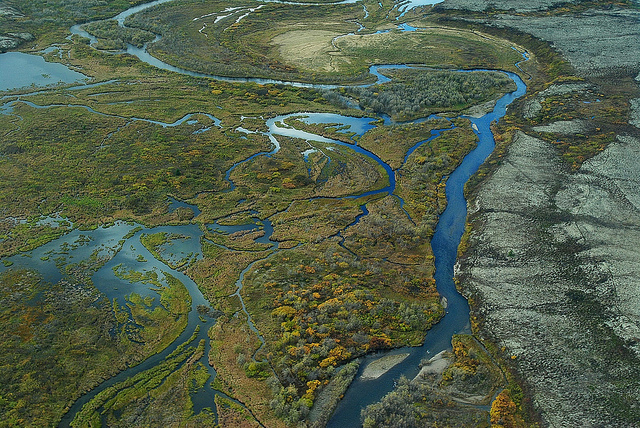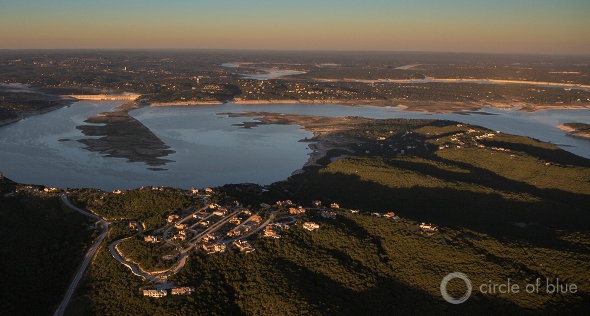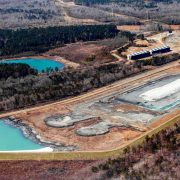Following EPA Action, Rio Tinto Exits Alaska Pebble Mine Project
U.S. agency moves to restrict development in Bristol Bay watershed.
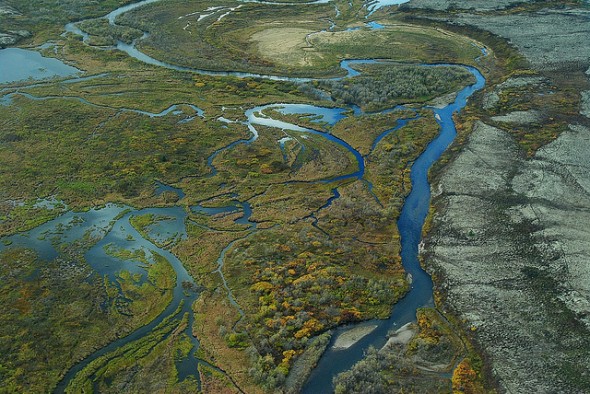
By Codi Kozacek
Circle of Blue
Six weeks after the Obama administration said it would act to protect one of North America’s last wild salmon fisheries in Bristol Bay, Alaska, one of the world’s largest mining companies announced on Monday that it is withdrawing from the Pebble copper mine development project there. The company, Rio Tinto, also said it was gifting its shares in the project to two Alaska public interest foundations.
Rio Tinto’s decision comes after the U.S. Environmental Protection Agency in February decided to pursue a regulatory process under the Clean Water Act that could preemptively restrict development of the mine in order to protect streams, wetlands and lakes in the Bristol Bay watershed. The EPA process, taken under section 404(c) of the federal Clean Water Act, gives the agency the authority to veto or preemptively block the U.S. Army Corps of Engineers and state agencies from issuing a permit for a development project to discharge material into waterways—a permit that would be necessary for a mine. A final veto has only been issued 13 times since 1972, when the CWA was passed.
In its February 28 statement announcing that it would initiate the 404(c) process in Bristol Bay, EPA Administrator Gina McCarthy called the bay “an extraordinary and unique resource.” Though a veto has not been issued for the Pebble project, the possibility was a factor in Rio Tinto’s decision to leave the development.
“We considered the project’s fit with the group’s strategy of investing in and operating long life and expandable assets,” David Outhwaite, principal advisor for media relations at Rio Tinto, wrote to Circle of Blue in an e-mail. “We also considered the recent regulatory action that will likely prevent the Pebble project from obtaining licenses for the foreseeable future and concluded that we should exit the ownership of Northern Dynasty Minerals, and concentrate on our existing copper projects.”
Large mining companies are definitely having to address local opposition in a more significant way than they have in the past.” — Bonnie Gestring,
Northwest Circuit Rider,
Earthworks
The Pebble deposit lies within the Bristol Bay watershed approximately 200 miles southwest of Anchorage, Alaska. It is estimated to contain more than 80 billion pounds of copper, 5.6 billion pounds of molybdenum, and 107.4 million ounces of gold, according to Northern Dynasty statistics. The EPA, in its watershed assessment, predicted that a mine at the site could generate between $US 300 billion and $US 500 billion in revenue over its lifetime. Because the minerals at Pebble are dispersed widely throughout the surrounding rock, the ore containing less than 1 percent copper by volume, the EPA also predicted that developing it will require a surface mine that could grow from a size of 1.5 square kilometers at 20 years to 17.8 square kilometers at 78 years, causing the eventual loss of 151 kilometers of streams. No official plans for the mine have been submitted, and Northern Dynasty is pursuing investigations into the preparation of the EPA watershed assessment, which it alleges was flawed.
Rio Tinto’s exit from such a potentially lucrative development—along with the September 2013 departure of Anglo American, another of the world’s largest mining companies—is a telling indicator of the pressures being placed on global corporations by environmental and grassroots organizations, and how both the companies and federal government are being forced to address public concerns about water. Anglo American, in particular, had already invested $US 556 million in the Pebble project at the time it withdrew. Though the company, much like Rio Tinto, cited a poor business fit as the reason it left the project, a report from Businessweek questioned the role of the No Dirty Gold Campaign. The campaign, organized by environmental nonprofit Earthworks, has secured pledges from 100 jewelry retailers, including eight of the top 10 in the U.S., to boycott gold produced at mines like the one proposed for Pebble.
“Large mining companies are definitely having to address local opposition in a more significant way than they have in the past,” Bonnie Gestring, Northwest Circuit Rider for Earthworks, told Circle of Blue. “We’re definitely seeing large companies factor in the level of local opposition in their decision making. If they don’t have the support of the local community, they face legal challenges, reputational challenges—impacts to the company’s reputation from moving forward without local support—and operational challenges. Large companies have to factor all of these in when pursuing a large project like the proposed Pebble mine.”
Once we get past the EPA issues, as soon as we do that, we expect to see another funding partner and the project will return on a normal track.” — Sean Magee,
Vice President of Public Affairs,
Northern Dynasty Minerals
But it’s not always local support alone. Social media have allowed organizations to spread their message more quickly and more widely, mobilizing a global community concerned about the mine. These efforts were evident in the public comments submitted to the EPA about its watershed assessment. A survey of the comments found that 98 percent from the Bristol Bay region supported EPA actions to protect the watershed, while 85 percent of comments from Alaska and 73 percent of comments overall supported EPA action.
“Certainly where the watershed assessment was concerned, there was a pointed effort by the environmental groups involved to get public comments in, but a lot of that just amounts to people clicking a button on a website somewhere,” Sean Magee, vice president of public affairs at Northern Dynasty, told Circle of Blue. “Using that to say that 98 percent of people are opposed to the project is not correct. It’s been a disappointment that the EPA has thought to publish those numbers, about how many e-mails it has received from groups like the NRDC [Natural Resources Defense Council], as evidence of public opinion. We think there is a far more complex stakeholder and social backdrop than that sort of statistic would suggest. ”
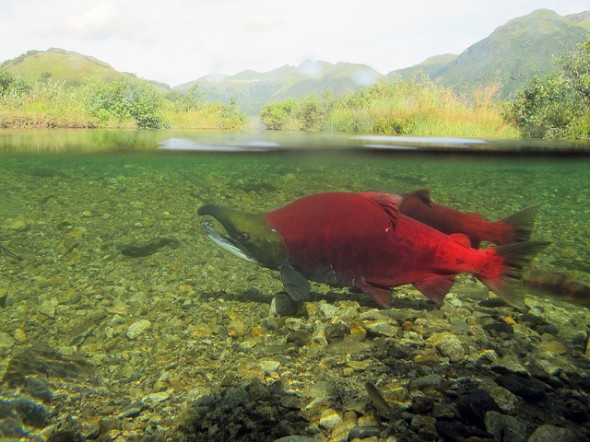
Differing Views on Pebble’s Future
Gestring and campaigners at other prominent environmental organizations, like the NRDC, largely see Rio Tinto’s announcement as one of the last blows to a doomed mine.
“Rio Tinto’s decision demonstrates once again that the project isn’t viable because of the impacts to the fishery that can’t be mitigated, and the local opposition to the project is simply too strong,” Gestring said.
She added that the EPA’s letter of determination under the 404(c) action, expected to be released in May, will be the “nail in the coffin” for Pebble.
“It’s quite certain that [the EPA] will provide restrictions within the watershed,” she said. “The extent of those restrictions is unclear at this point, but they said clearly that they plan to follow the science in the watershed assessment, and that makes clear that 94 miles of salmon streams would be lost if mine waste is disposed. They will need to make very significant restrictions to protect the watershed.”
Northern Dynasty, now the sole mining company behind the Pebble project and a 100 percent owner, has a very different outlook. The company has two main priorities this year, according to Magee. They include shifting assessment of the Pebble project to a more traditional permitting process, rather than the 404(c) action the EPA has initiated, and bringing in another major funding partner. The process to find another partner has already started, and a handful of international companies have shown interest, he said.
“Once we get past the EPA issues, as soon as we do that, we expect to see another funding partner and the project will return on a normal track,” he said.
It’s quite certain that [the EPA] will provide restrictions within the watershed.” — Bonnie Gestring,
Northwest Circuit Rider,
Earthworks
Northern Dynasty has until the end of April to submit documents to the EPA showing that development of a mine at Pebble would not have significant adverse effects on the environment, at which point the agency will have 30 days to issue a draft letter of determination outlining their proposed restrictions for the Bristol Bay watershed. At the same time, the U.S. House Oversight and Government Reform Committee is subpoenaing the EPA for its documents regarding the Pebble project. The committee’s chairman, Darrell Issa, R-Calif., and two subcommittee chairmen—James Lankford, R-Okla., and Jim Jordan, R-Ohio—also requested that the EPA Inspector General investigate the agency’s decision to pursue 404(c) action. The committee says that documents show the EPA discussed using their veto power to stop the Pebble development before the watershed assessment was completed.
“At the end of the day, the EPA’s statutory authority to undertake a preemptive action is questionable, and using the Bristol Bay study as a scientific basis when it is based on hypothetical mine plans is questionable,” Magee said. “There is a lot of concern, and growing concern, in the state government and among landowners about this process.”
New Shareholders in Pebble Project Are Alaska Charities
In the meantime, Rio Tinto’s departure has left its 19.1 percent share of Northern Dynasty stock divided equally between the Alaska Community Foundation and the Bristol Bay Native Corporation Education Fund, two Alaska charities.
“We will use the proceeds [of this fund] to promote workforce development,” Candace Winkler, President and CEO of the Alaska Community Foundation, told Circle of Blue.
She explained that in the case of unusual gifts, such as stock, the foundation’s investment committee and investment board work on a strategy to integrate the donation into current investment policy and portfolios. The foundation is still evaluating the timeline and strategy for dealing with the Northern Dynasty stocks.
“We are just working through the steps,” Winkler said. “We are really excited to have the opportunity to work on workforce development issues. We think it will have a big impact on the economy across the state of Alaska, both in resource development jobs but also other community development jobs that arise in that area. We understand this is a pretty complicated issue and people have strong feelings on both sides, and we are not weighing into the political space.”
Obviously we would like both the Alaska Community Foundation and the Bristol Bay Native Corporation Education Foundation, and the people they serve, to generate the maximum value from those shares.” — Sean Magee,
Vice President of Public Affairs,
Northern Dynasty Minerals
The Bristol Bay Native Corporation, however, has previously made its opposition to the Pebble mine known.
“Rio Tinto deserves credit for its willingness to reconsider its position in the Pebble Project. This gift provides an example of what open discussion and relationship building between stakeholders with differing views can accomplish,” BBNC President and CEO Jason Metrokin said in a statement following this week’s donation. “However, BBNC’s opposition to the proposed Pebble mine has not changed.”
Magee said BBNC’s 10 percent share in Northern Dynasty would give them voting rights on governance issues, if they decide to keep the stocks, but is far from giving them control of the company.
“Obviously we would like both the Alaska Community Foundation and the Bristol Bay Native Corporation Education Foundation, and the people they serve, to generate the maximum value from those shares, and we will be discussing with them our views of how that might be accomplished,” he said. “The potential here is that the people of Bristol Bay in Alaska will have a direct stake in the project, and any time you have local ownership and the opportunity to encourage local input, it can be a significant benefit for advancing the project.”
Earthworks’ Gestring also stressed the importance of community involvement.
“Certainly we’ve seen companies walk away from projects before, but I’ve never seen a company donate shares to community charities, so that is breaking new ground and we commend Rio Tinto for that,” said Earthworks’ Gestring.
“I think it’s important to know that in Rio Tinto’s decision to withdraw from the Pebble project, they said that Alaskans should have a say in Pebble’s development,” she continued. “We think that’s absolutely true and we applaud them for it. There is clearly overwhelming opposition to the mine.”
A news correspondent for Circle of Blue based out of Hawaii. She writes The Stream, Circle of Blue’s daily digest of international water news trends. Her interests include food security, ecology and the Great Lakes.
Contact Codi Kozacek

